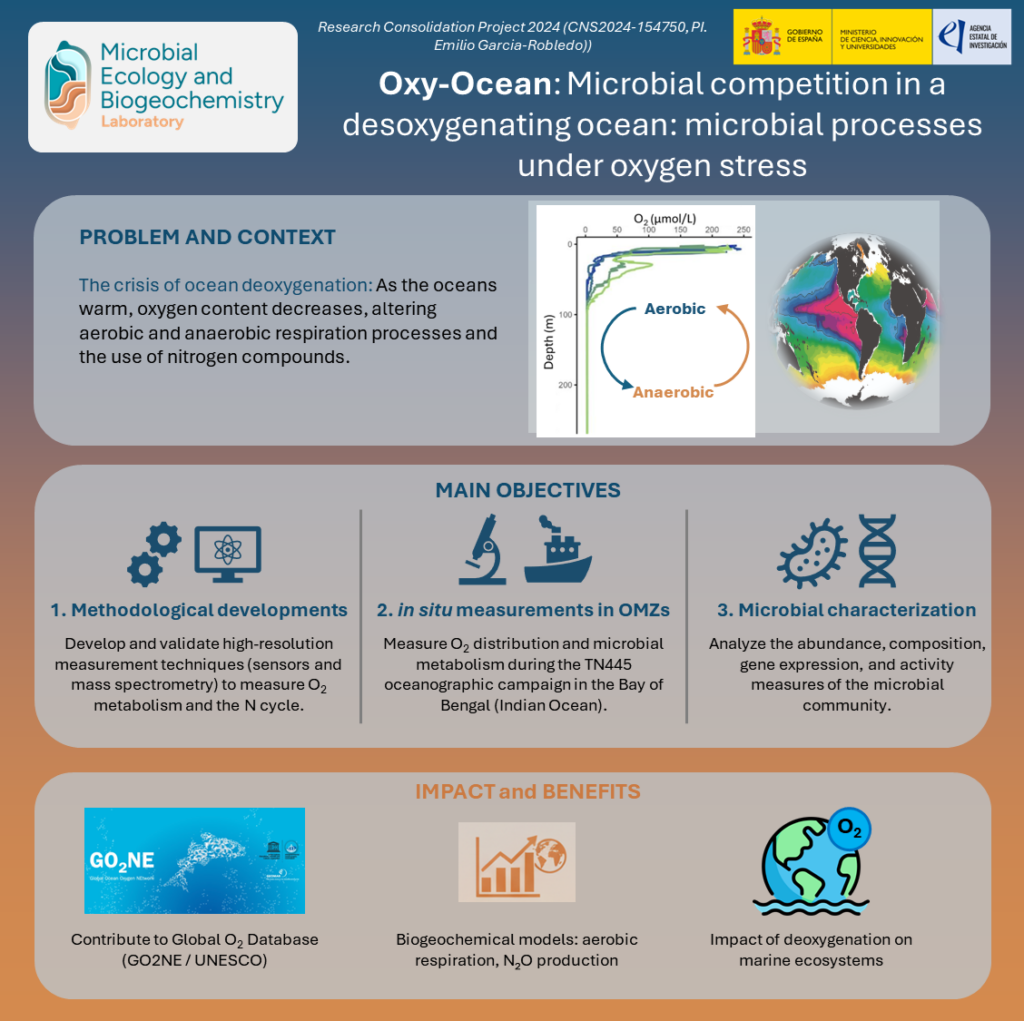Research Consolidation Project 2024 (CNS2024-154750, PI. Emilio Garcia-Robledo)

Exploring Microbial Metabolism Under Oxygen Stress
The Oxy-Ocean project (Microbial competition in a deoxygenating ocean: microbial processes under oxy-stress) addresses a critical challenge in modern oceanography: the increasing ocean deoxygenation and its impact on the global carbon and nitrogen cycles, as well as on climate. Led by Principal Investigator (PI) Emilio G. Garcia Robledo, this project seeks to understand how marine microbial communities manage the transition from aerobic to anaerobic processes in very low-oxygen environments, such as Oxygen Minimum Zones (OMZs).
The Heart of the Problem: Metabolic Transition
In marine environments, microbial life undergoes a crucial transition from aerobic respiration (which uses O2) to anaerobic metabolisms (such as denitrification and anammox, which use oxidized nitrogen compounds like NOX–) as oxygen decreases. This transition has direct and significant consequences:
- Nitrogen (N) Cycle: Denitrification and anammox convert bio-available N into unavailable gaseous N2, affecting global marine productivity. On the other hand, Dissimilatory Nitrate Reduction to Ammonium (DNRA) retains N in the system.
- Global Climate: The N cycle in these zones can produce nitrous oxide (N2O), a potent greenhouse gas.
Historically, it has been assumed that the shift to anaerobic pathways is directly linked to the complete absence of O2. However, the O2 threshold for this shift is highly variable, which affects global modelling.
Key Objectives of the Oxy-Ocean Project
The main objective is to evaluate how oxygen concentration and the environmental stability of oxic conditions influence the transition and coexistence of aerobic and anaerobic metabolism.
- Development of Precision Methodology:
- Validate new incubation vessels to precisely control O2 concentrations at trace and anoxic levels.
- Develop procedures to use a Mass Spectrometer to simultaneously measure O2 consumption rates and N cycle processes (denitrification and anammox) under trace and anoxic O2 conditions.
- Quantification in OMZs:
- Participation in an oceanographic campaign to the Bay of Bengal Oxygen Minimum Zone to sample stations with stable and unstable oxic conditions.
- Simultaneous measurement of aerobic respiration and N metabolism processes in a range of low and trace O2 concentrations.
- Characterization of high-resolution O2 distribution using STOX and SBE-43 sensors.
- Analysis of microbial abundance and composition (flow cytometry) and gene expression (metagenome/metatranscriptome) of key genes related to O2 and N metabolisms.
Expected Impact
The results of Oxy-Ocean will not only generate cutting-edge scientific knowledge on marine microbial ecology and its response to deoxygenation, but will also have a direct impact on society and climate modeling:
- Model Improvement: Nanomolar O2 data and metabolic transition thresholds will allow for the improvement of current marine biogeochemical models, more accurately estimating deoxygenated marine areas and N2O production.
- Information for Management: The information is crucial for organizations such as the Global Ocean Oxygen Network (GO2NE) and managers of vulnerable coastal environments, helping to inform strategies to mitigate the consequences of deoxygenation on ecosystems and services such as fisheries and aquaculture.



